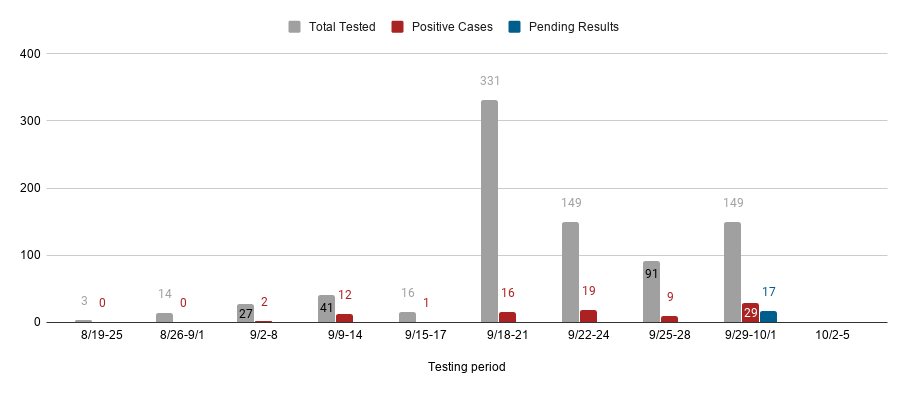Cardinals In Quarantine: COVID-19 Makes Landfall On Campus

Image Courtesy of The Catholic University of America
By Justin Lamoureux
All eyes were on Walter Reed Medical Center in Bethesda this weekend, as President Donald Trump announced via Twitter that both he and the first lady had tested positive for the coronavirus. What has not received widespread media attention – though remains considerably more relevant to the lives of Catholic University students – is the substantial uptick in COVID-19 cases both on and off campus.
Since classes started on August 24, 872 Catholic University students have been tested at the Catholic University testing center on campus for coronavirus. As of October 8, among those students both on and off campus evaluated at the site, 101 (8.6%) were found to have COVID-19. The overwhelming majority of cases (and tests) occurred following the quarantine period, and commencement of in-person classes on September 8.
Since September 9 (two days following the end of quarantine), 826 students have been tested for coronavirus at the Catholic University testing center on campus – 99 of those recipients tested positive. As demonstrated by the visual above, the number of tests – and specific infection rates – fluctuate by week, but the overall positivity rate (for the last month) stands at 12%. That’s nearly three times the current national rate of 4.7%, and nearly ten times the District of Columbia’s most recent statistic (1.3%).
It should be noted that significant increases in testing – and, in turn, positive cases – can be attributed largely to the university’s “surveillance testing” (or “intentional testing of nonsymptomatic students”) of student athletes. Nevertheless, many students are beginning to find their routines disrupted by the virus, as many professors have elected to move classes online as increased numbers of students have entered quarantine. An isolation dorm has been set up in Millennium Hall to accommodate students asked to isolate themselves as a precautionary measure.
Granted, a majority of cases were found in students living off campus. Within the confines of on-campus residential life, however, the vast majority of positive cases can be traced to a single location: Opus Hall.
An email was sent to the entire residence hall on Friday evening, disclosing that “37 [nearly two-thirds] of the confirmed on-campus cases involve Opus residents.” Speculation has likewise ensued that an entire floor of students has been placed on lockdown due to a concentration of cases. Community directors have consequently implemented new restrictions on residents, the stringency of which exceeds constraints placed on all students during the campus-wide quarantine period: Not only is all visitation to Opus suspended “through at least October 18,” all lounges and common areas have also been shuttered. Visits to floormates and residents on other floors has also been prohibited.
Other residence halls may not be on high alert, but events playing out in Opus certainly present a legitimate concern to all students living on campus. More than anything else, they present a foreboding of what could happen if the right precautions are not taken. All students must continue to complete the daily health check (sent by text message and email every morning), wear face coverings when outside their suites, maintain proper social distancing from others, and ensure good hand hygiene (i.e. wash their hands and apply hand sanitizer regularly).
It goes without saying that Catholic University freshmen (and the select upperclassmen living on campus) are currently in a unique situation: They are currently the only D.C. university students to be residing, or attending classes, on campus. This presents an opportunity to demonstrate an exceptional form of resilience, but also an obligation to exercise vigilance.
Right now, there are no guarantees in anything; if people approach this absent-mindedly, the consequences will be widespread and costly. Students’ lives may revolve around Catholic University, but keep in mind that COVID-19 is a global pandemic: everyone is at risk.






